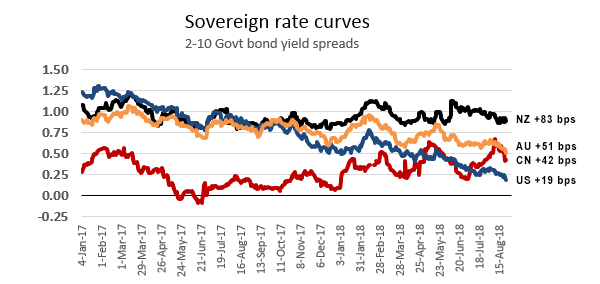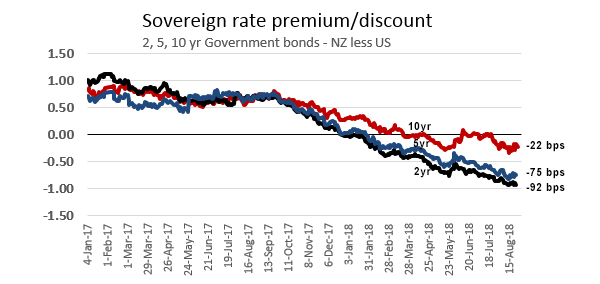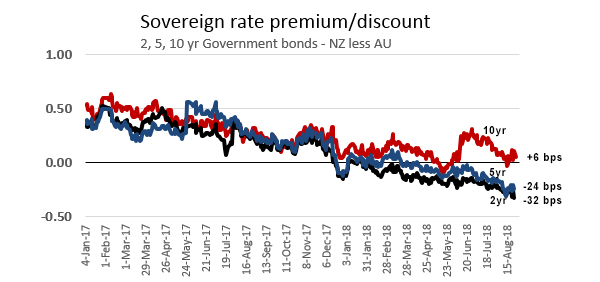
The warnings from the bond market are getting serious.
Today, the US 2-10 yield curve dropped below +20 bps for the first time in more than a decade. In fact they didn't just drop, they fell sharply.
The 2 year UST yield ended the week at 2.624%. The UST 10 year yield ended at 2.813%. The difference is a positive yield curve of only +18.9 bps. That is low, but more importantly, it is falling fast. At the start of August this curve was +33 bps. At the start of 2018 it was +52 bps. At the start of 2017 it was +123 bps. You get the idea.
If it keeps falling at this rate, the positive yield curve will be gone by mid October.
But well before that, investors will wake up to this signal. It may not result in a pleasant realisation, with reactions becoming self-fulfilling.
Back in May 2018 we assessed these same trends. Back then we observed:
When longer-term interest rates fall below short-term rates, investors may be signaling a lack of confidence in future growth. The phenomenon often precedes a recession. We are not there yet, but in less than eighteen months the 2-10 difference has gone from about 120 bps to just over 40 bps; that is not only a big move, it has been a steady and relentless one. It is the bond market sending a powerful, consistent signal.
Since then the pace seems to have piced up.
Bank in May, we also looked at the shift from where New Zealand rates moved from a premium to the US ones, to a discount. That is important too.
New Zealand rates are a model of stability, not only compared to the US, but to China and Australia as well.
New Zealand rates are now generally lower that all equivalent US and Australian rates for the same terms, the exception being the Aussie ten year and there we are more or less equivalent.
But while they are now lower, they still show a much more positive curve.
Here is the recent track of how the curves for three key countries compare with New Zealand

Notice how stable the Kiwi curve is compared to the others, especially the US.
And here is the recent track of the rate premiums for New Zealand, forsly vs the US ...

and then vs Australia.

In less than one year, both relationships have moved dramatically - and are still in motion.
You can make your own assessment about what is being signaled here (and for an alternate view, see this), but for me this is a major indication that investors don't think the US is on the right path. And I think quite soon (when the premium drops below +10 bps) there could be a general market epiphany. It is not unreasonable to assume that the fall from there will be quite substantial and sudden, pushing the curves into negative territory until a change of policy direction in the US is evident.
Be thankful we are tucked away in a calmer pocket of the world, with policy makers who are professional and who actually do have some ammunition available to lean against the worst excesses that may come. But we won't be immune to blowback.
7 Comments
Without getting too lost in it all I have read a few articles that suggest the ultra-low European rates – Bund 10 Yr .343% etc – are in some respects holding the US 10 Yr back.
A negative yield curve in this instance may not necessarily be as indicative of the future as it has in the past – never before seen QE combined with ultra-low interest rates is a brave new world – both in terms of implementation and removal.
Yes, I know – the “this time it’s different” chestnut…..
Yes, seismically different. Being the little player with more flexibility and inherent stability in our democracy in all of this.. surely we ought to be able to work the shift in our favour somehow.
My guess is that the NZ stability is an illusion. Interest rates are stable but the currency is not. Money appears to be moving into US T bonds , and this is pulling all currencies down. The US Treasury is seen as the safest investment on the planet.
The parallel process that reinforces this is borrowing in local currency and buying USD to repay USD debt. If the local central bank doesn't have the USD to hand, then it will lend out gold for USD to cover the shortfall. In the short term this allows them to effectively sell gold, buy USD and buy the gold back at a later date. So gold goes down too, against the USD anyway, maybe not against the local currency.
All seems well in NZ at the moment. I guess there could soon be a problem with construction projects getting stopped, or delayed indefinitely, because the NZD has gone down since the estimates were made and the imported materials now cost a lot more. So projects that are underway get completed, but ones where the costs have gone up don't get started. This is a big deal as it affects a lot of jobs, but it takes time to bite. I wonder how much this contributed to the collapse of the major building firms and Fletcher's major losses?
https://www.nzherald.co.nz/business/news/article.cfm?c_id=3&objectid=12…
"He gives a strong indication that CRL might cost more than projected....."
When approved by Len Brown and then John Key, the estimate was $2.8 billion. Lets see what the bids come in at....
30 year US bonds are trading at 2.961% , inflation in the USA CPI is around 2.9% although many think inflation is higher in the USA.
"What Powell should have said. "The economy is doing okay. Wage growth and full-time employment for most American's remains elusive. Real inflation of the average household is north of 5% and all our policy actions did was enrich all of our friends in Washington and Wall Street." Lance Roberts.
So why are pension funds etc buying bonds with no compounding interest, workers are saving today, to get the same value of money out in 30 years time as they put in?
It could be "liquidity preference" ie, the liquidity is important more important than the return in other investments that carry risk, someone thinks that risk is not worth it, returns in a low ZIRP environment are hiding the wounded and sick.
Its gone from all reward with no risk to all risk with no reward. No different than my business, low rates have left the heavily indebted to soldier on, instead of being forced to exit and be replaced by new entrants with lower debt and capital values.
https://www.businessinsider.com.au/liquidity-in-the-bond-market-2015-4?…
The 'Dark Money' is giving us a clue to whats happening in the real world
http://www.alhambrapartners.com/2018/08/24/eurodollar-university-dark-m…
Debt zombies are going to be a problem when interest rates change. I'm wondering how many mismanaged companies will collapse? How many will be like Enron with dodgy books?

We welcome your comments below. If you are not already registered, please register to comment
Remember we welcome robust, respectful and insightful debate. We don't welcome abusive or defamatory comments and will de-register those repeatedly making such comments. Our current comment policy is here.